“I hope I’ve done justice to the honour I was given”: Senator Bovey bids the Chamber goodbye
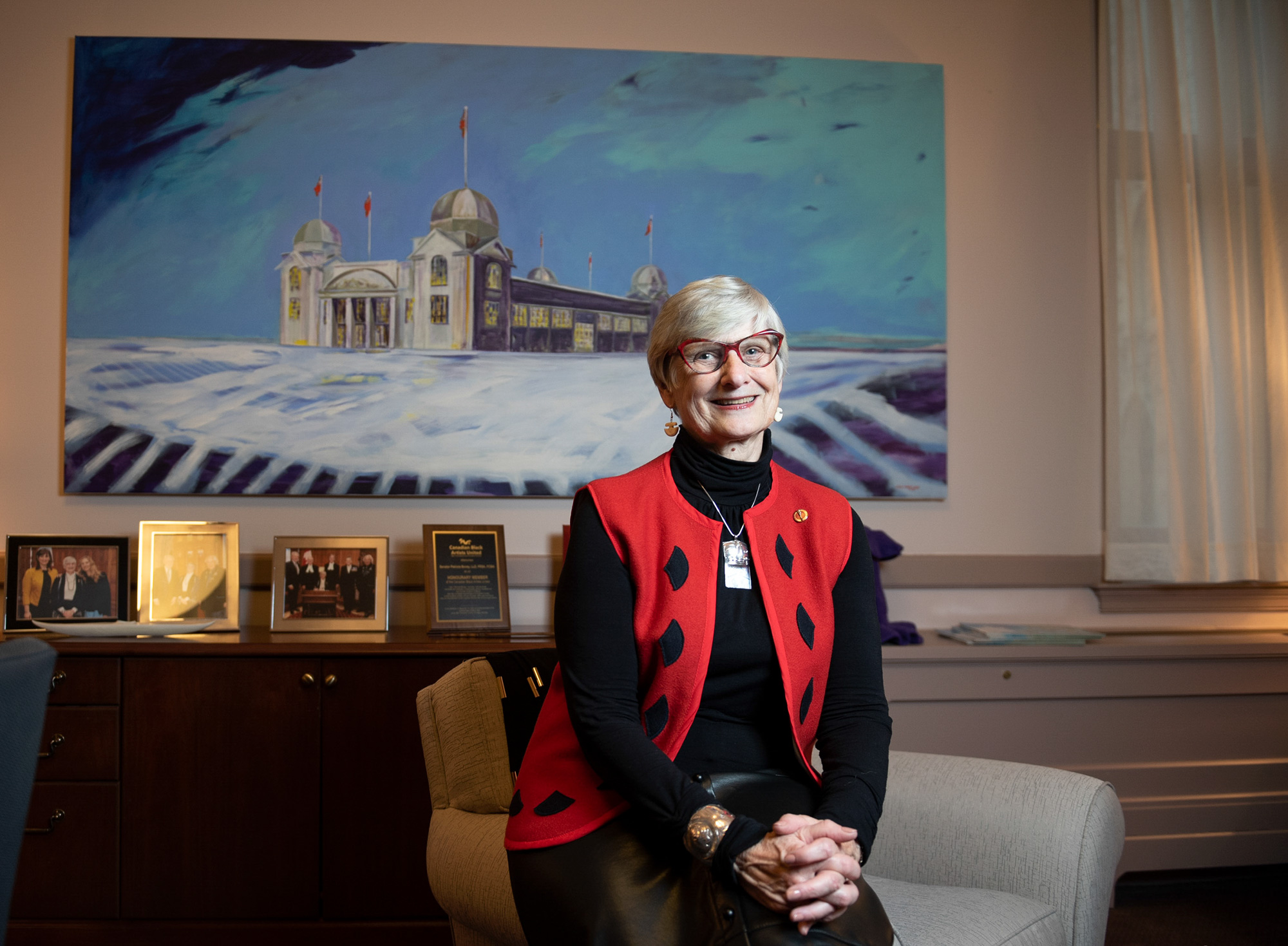
The Senate of Canada is filled with accomplished Canadians representing diverse professions, but Senator Patricia Bovey’s appointment in 2016 marked a first for the 150-year-old institution: the senator for Manitoba was the first art historian and museologist to serve in the Senate. With a six-and-a-half-year runway in the Red Chamber, she got straight to work. A strong and passionate advocate for arts and culture, she brought that perspective to every aspect of her work while spearheading new programs to showcase artwork at the Senate.
Before leaving the Upper Chamber on May 15, 2023, Senator Bovey sat down with SenCAplus to reflect on her time in the Senate.
How did your career in the arts industry prepare you for life on Parliament Hill?
I think my life as an art historian and gallery director was the best training anybody could possibly have to be on the Hill. One’s always working on multiple files simultaneously. One works with people of all backgrounds, cultures, diversities and ages. In the art museum world, we are presenting the ideas expressed in the work of creators to audiences; on Parliament Hill and the Senate, we’re working on and presenting issues that affect individuals and that have strong impacts on Canadians.
You were appointed to the Senate in 2016. What was it like getting that phone call from the prime minister?
It was really exciting. He said to me that he wanted me to be in the Senate, that I was to be independent — which I always have been — that I was to work on everything, and that he wanted me to approach everything through the lens of arts and culture. And that’s exactly what I’ve done. Being the first art historian and museologist in the Senate, I layered on top of that the fact that that segment of Canadian society — the third-largest employer in Canadian society — hadn’t had a voice on Parliament Hill.
You have two Senate public bills that passed the Senate unanimously. The first, Bill S-202, is your third attempt to create the position of Parliamentary Visual Artist Laureate. How would Parliament benefit from having an advocate for the visual arts?
 Senator Bovey spreads holiday cheer during the Senate’s Toys for Tots drive in December 2017. The annual campaign collects donations for underprivileged children in the National Capital Region. (Photo credit: Office of Senator Patricia Bovey)
Senator Bovey spreads holiday cheer during the Senate’s Toys for Tots drive in December 2017. The annual campaign collects donations for underprivileged children in the National Capital Region. (Photo credit: Office of Senator Patricia Bovey)
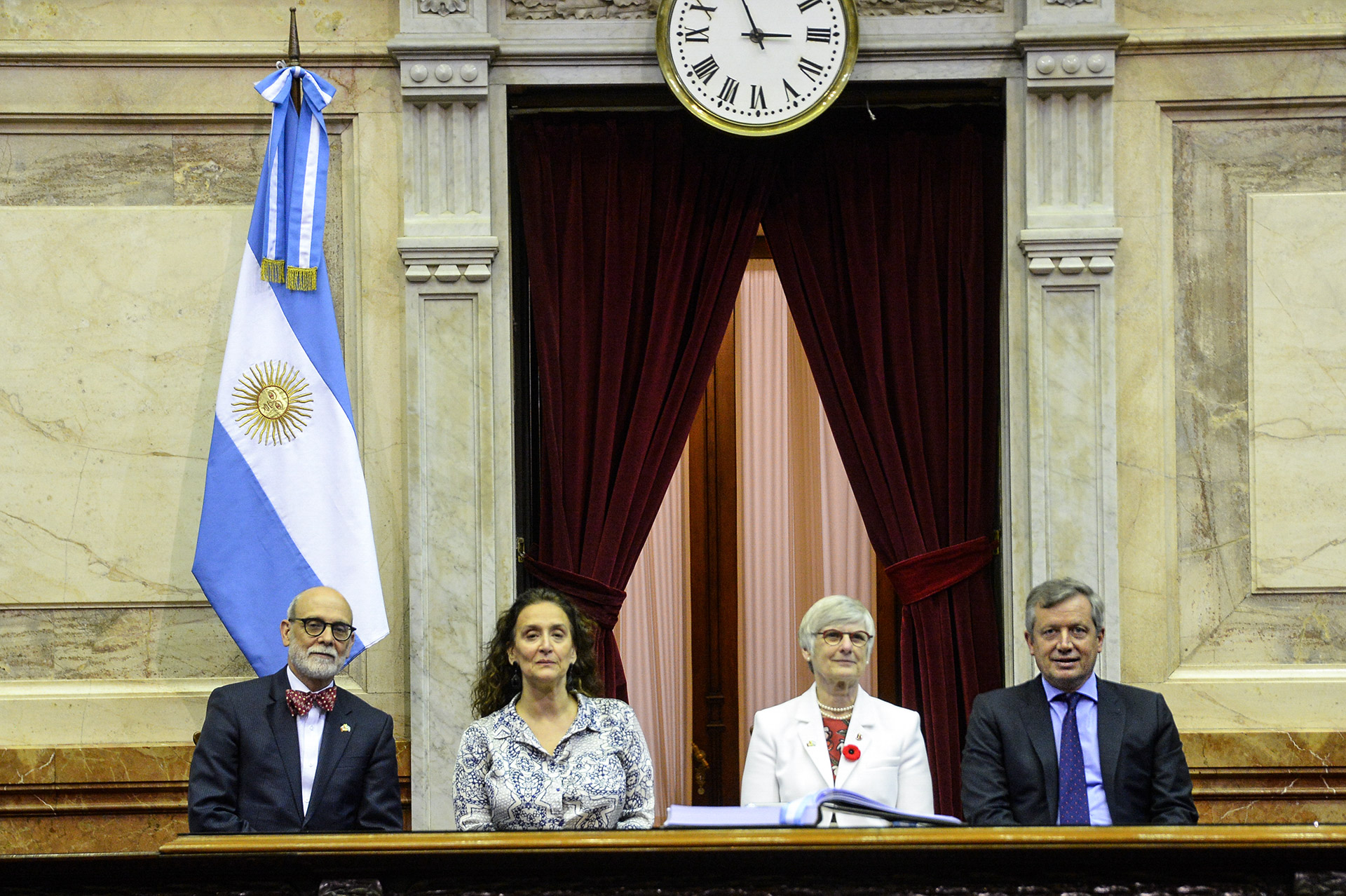 Senator Bovey represents Canada during the Parliamentary Speakers’ Summit at the G20 in Buenos Aires, Argentina, in 2018, where she spoke about women’s empowerment. From left, she is pictured with: David Usher, then Canada’s ambassador to Argentina; Gabriela Michetti, then vice-president of Argentina; and Emilio Monzó, then president of the Argentine Chamber of Deputies. (Photo credit: Office of the Speaker of the Senate)
Senator Bovey represents Canada during the Parliamentary Speakers’ Summit at the G20 in Buenos Aires, Argentina, in 2018, where she spoke about women’s empowerment. From left, she is pictured with: David Usher, then Canada’s ambassador to Argentina; Gabriela Michetti, then vice-president of Argentina; and Emilio Monzó, then president of the Argentine Chamber of Deputies. (Photo credit: Office of the Speaker of the Senate)
Having the ability to put the work of Parliament out there in the international language of visual art is absolutely critical and very exciting. As with the Parliamentary Poet Laureate, the visual artist laureate would draw attention to and increase awareness of the visual arts. The position would help the visual arts, but I think it would really help parliamentarians, which is why I think it’s getting such positive comments in the House of Commons.
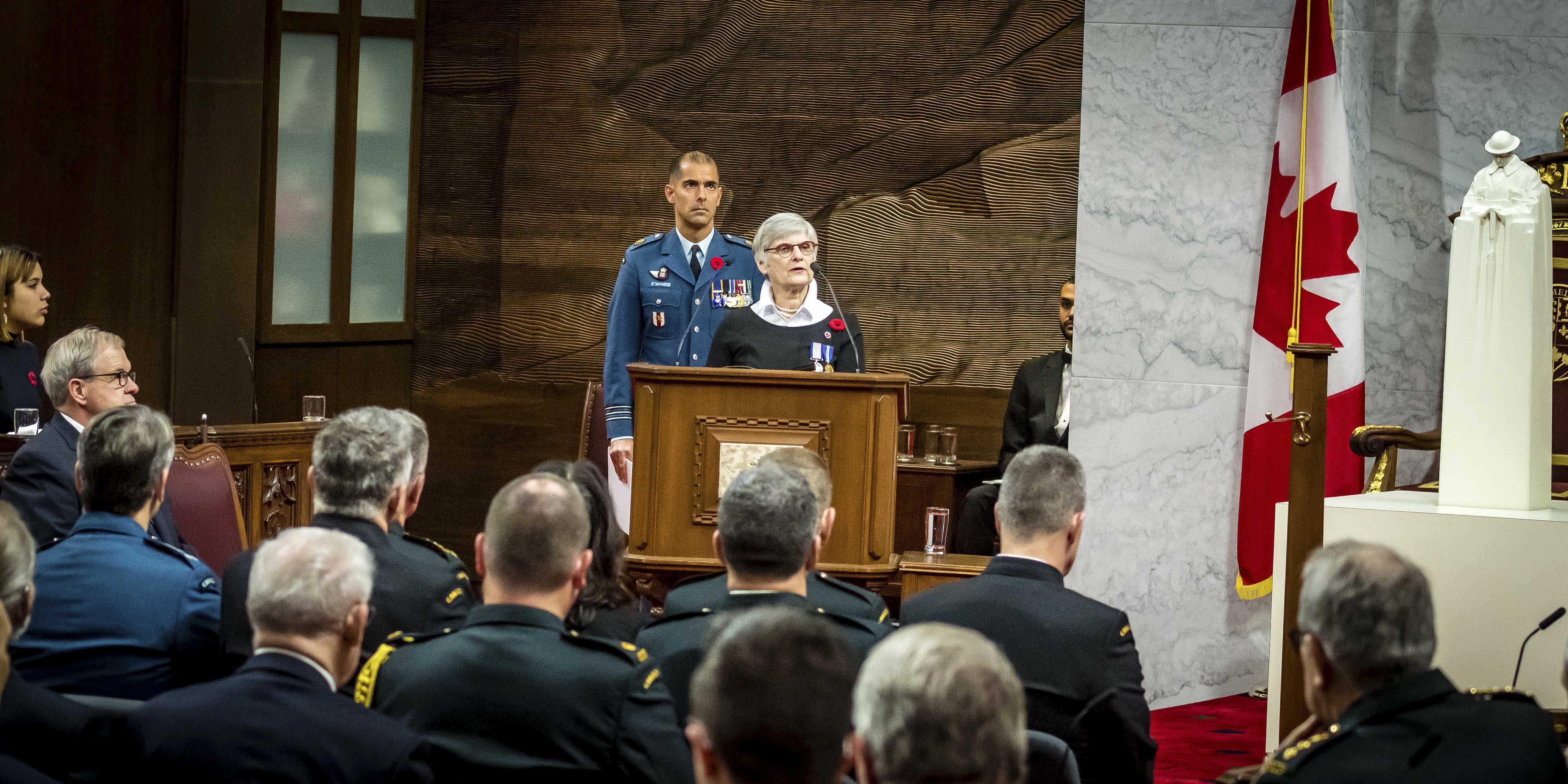
Senator Patricia Bovey delivers remarks as acting Speaker of the Senate during a 2019 Remembrance Day ceremony in the Red Chamber. (Photo credit: Office of the Speaker of the Senate)
Your second bill, S-208, would provide for the implementation of a 10-point Declaration on the Essential Role of Artists. What do you hope this declaration would achieve in the long term?
The arts, so often, are put in a silo and seen as something for people who have time and money, when in fact the arts are absolutely critical to every aspect of society. We know that people who attend arts events live two years longer, cost the health system less, miss less work and get out of hospital earlier after surgery. We know that if at-risk youth are involved in creative endeavours, the crime prevention is significant and the recidivism rate of those young people goes way, way down. With increasing urbanization, we know that it’s arts festivals that have enlivened small communities. The economic impact is huge.
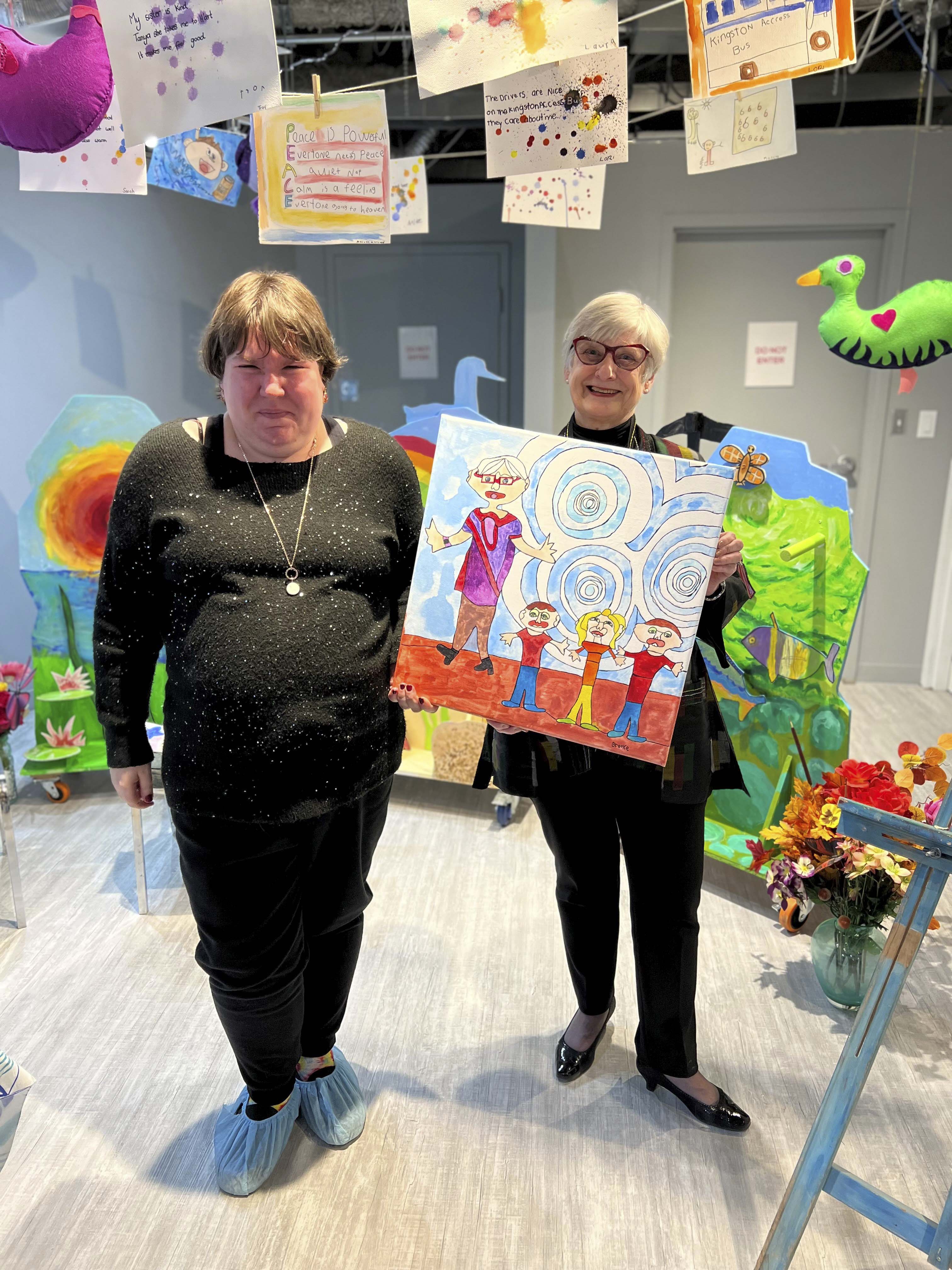 Artist Brooke D. presents Senator Bovey with a portrait she painted of the senator in March 2023 at the H’art Centre, which provides arts, music, dance and theatre programming to adults with disabilities in Kingston, Ontario. (Photo credit: Office of Senator Patricia Bovey)
Artist Brooke D. presents Senator Bovey with a portrait she painted of the senator in March 2023 at the H’art Centre, which provides arts, music, dance and theatre programming to adults with disabilities in Kingston, Ontario. (Photo credit: Office of Senator Patricia Bovey)
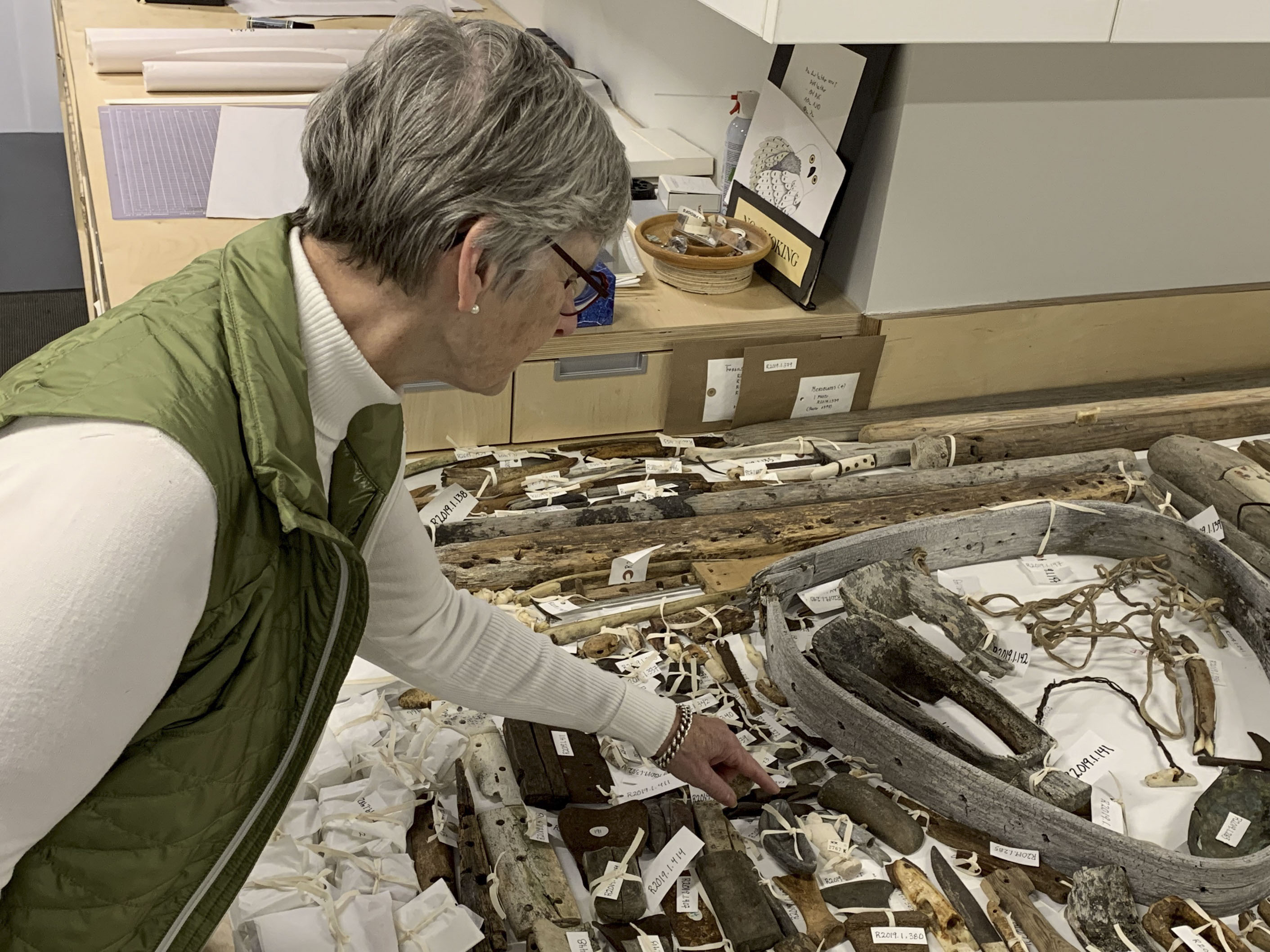 Senator Bovey visits the West Baffin Eskimo Co-operative in Kinngait (formerly Cape Dorset), Nunavut. (Photo credit: Office of Senator Patricia Bovey)
Senator Bovey visits the West Baffin Eskimo Co-operative in Kinngait (formerly Cape Dorset), Nunavut. (Photo credit: Office of Senator Patricia Bovey)
We know that arts and culture is the third-largest employer in Canada and yet, the largest percentage of working poor in Canada are artists living below the poverty line. So there’s some issues that we’ve really got to look at, and the declaration, I hope, will bring a lot of this to light. It’s a foundation piece of legislation so we can build up.
In addition to your advocacy for the arts, you have been a member of several Senate committees and subcommittees. What other work or initiatives are you the most proud of?
I was deputy chair of the Senate Committee on Transport and Communications when we did the study on autonomous vehicles. I became hooked! I’m very proud of that study. I’ve also been deputy chair of the Social Affairs, Science and Technology Committee, and we’ve been working on the framework for suicide prevention and the study on Bill C-22.
I called for and participated in the Foreign Affairs and International Trade Committee’s study on cultural diplomacy. The report, Cultural Diplomacy: At the Front Stage of Canada’s Foreign Policy, has received a huge amount of support. The other piece I’m really proud of is the work we did on the Special Senate Committee on the Arctic — of which I was deputy chair. I think it was a substantive report.
I was very honoured when the Speaker asked me to be a backup, and so for a period of two years plus, I was often acting Speaker. I was honoured when he asked me to represent him in Argentina at the G20 Parliament Speakers’ Summit and I represented him in Mexico at a Canada-Mexico meeting.
It’s such an honour to be in the Senate. And as I head out, all I can say is: I really hope I’ve done justice to the honour I was given. I hope I’ve represented the Manitobans I was there to represent. And I really hope I’ve represented the creators in this country in all disciplines.
The Senate of Canada is the custodian of more than 6,000 works of art, ceremonial objects and heritage furniture. What do you think is important Canadians know about the Senate’s art collection?
I think Canadians need to know that there’s a very impressive collection of art here, held in the pubic trust, and that the Senate’s Artwork and Heritage Advisory Working Group developed a very solid policy for that public trust. We are adhering to Canadian museum standards; our working group deals with acquisitions and deaccessioning in the highest professional and legal manner; and the programs that we’ve instituted are important to that end.
Cultivating Perspectives gives the opportunity to professional curators across the country to write about work in the Senate collection, thereby giving it presence. We’re in the throes of strengthening the Indigenous collection, and initiated the Museums at the Senate program. Our programs like Honouring Canada’s Black Artists and Visual Voices are giving voice to and giving presence to the rich, cultural and diverse dimensions of this country.
Reflecting on those physical and online exhibitions, what are you most proud of?
I’m proud of the fact that people are now aware — or becoming aware — of what’s here and want to work with us in understanding Canada’s multicultural dimensions. If we helped artists in their careers and their work in any way, I’m thrilled with that. And I think this comes back to the declaration — how important I think the declaration is to pull all that together. I hope we don’t lose what we’ve gained.
What advice would you give to future senators?
Embrace it. Work with it. Don’t lose sight of your own focus, but always be tuned in to the focuses of others and look for bridge building. Don’t be afraid to ask questions! And don’t be afraid to take on committees. The more you put into it, the richer your platform will be when you leave.
We developed a strategic plan for my office, knowing I was only going to be in the Senate for six and a half years and wanting to be sure we focused on my key goals as well as everything else. If I was advising other senators, I would recommend doing and updating a strategic plan. It was very helpful for me.
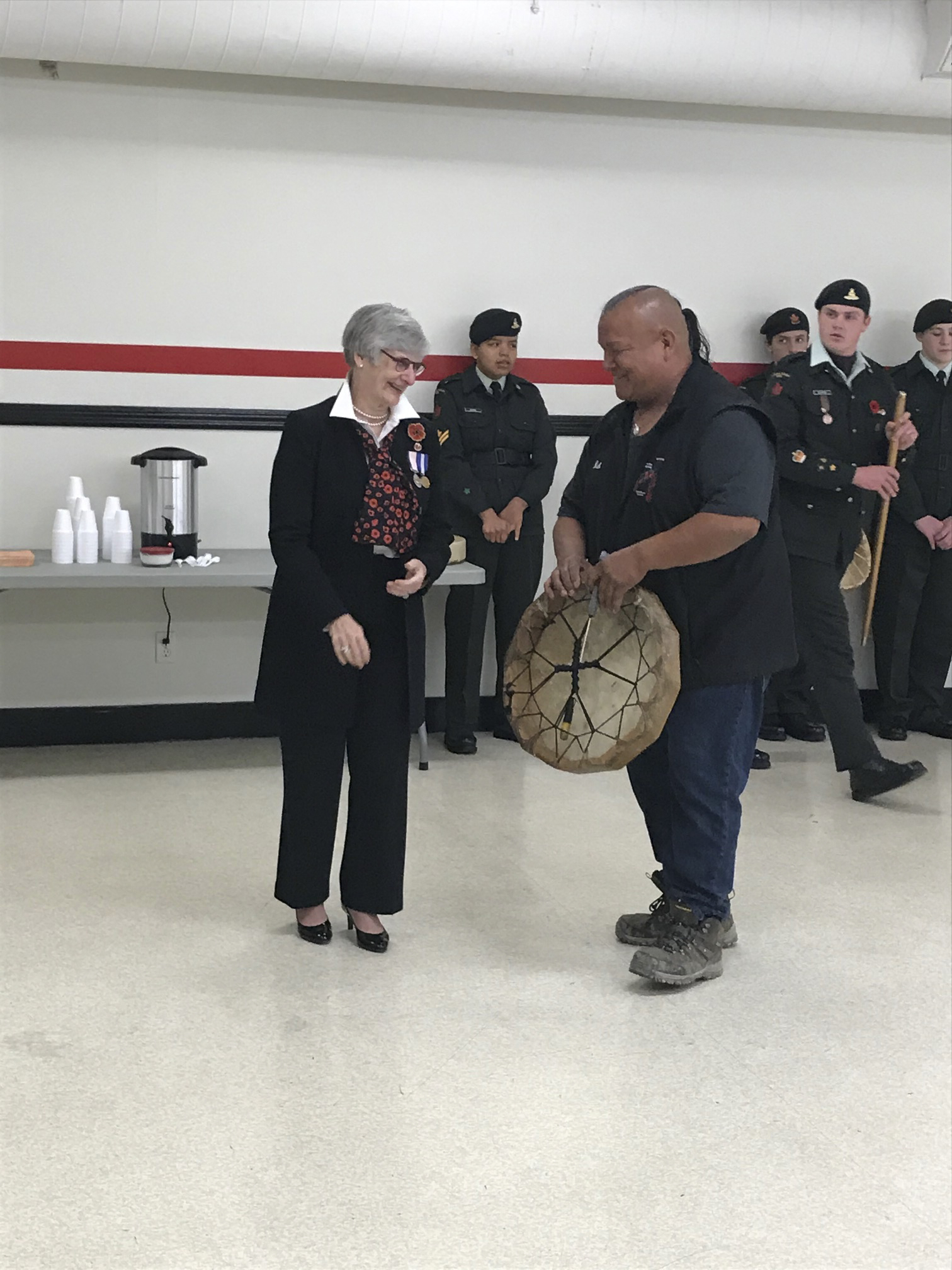 Senator Bovey visits the 2924 Khowutzun Royal Canadian Army Cadet Corps in Duncan, British Columbia, in 2019. (Photo credit: Office of Senator Patricia Bovey)
Senator Bovey visits the 2924 Khowutzun Royal Canadian Army Cadet Corps in Duncan, British Columbia, in 2019. (Photo credit: Office of Senator Patricia Bovey)
I really believe that I’m fortunate with the best staff in the Senate. I think people were surprised that I didn’t bring in people I’d worked with before. I knew I needed people who knew the Hill. I would give that piece of advice to anybody. I felt the need to work with people who could help me in the milieu I was coming into and I’m very grateful to Christine Sentongo-Andersen and Archie Campbell for having done that.
What are your post-Senate plans?
I feel what I’ve gained in the Senate and been able to achieve, as well as that which is still ‘in the works,’ will be the foundation for my next new chapter. That will include the work I’ve started on dealing with fraud against Canadian artists, and particularly Indigenous artists. I’m going to continue to monitor the Copyright Act and the commitment I’ve had from a number of ministers that artists’ resale rights will be enshrined, and, of course, working with the creative sector on climate change will be important too. All these issues were on my plate before and during my time in the Senate and will continue to be. I am not closing the door!
I obviously want to keep involved in my community and in national engagement, but I’m not sure what form any of that will take. My book, Western Voices in Canadian Art, has recently been published and I have some other writing projects ahead. Art colleagues across the country are setting up some speaking tours for me for my book, and that will keep me going, but working in and with community is really important to me — indeed, the essence of who I am.
 Senator Bovey kayaks in the waters off Victoria, British Columbia in 2018. (Photo credit: Office of Senator Patricia Bovey)
Senator Bovey kayaks in the waters off Victoria, British Columbia in 2018. (Photo credit: Office of Senator Patricia Bovey)
Note to readers: The Honourable Patricia Bovey retired from the Senate of Canada in May, 2023. Learn more about her work in Parliament.
Related articles
Tags
Committee news
“I hope I’ve done justice to the honour I was given”: Senator Bovey bids the Chamber goodbye

The Senate of Canada is filled with accomplished Canadians representing diverse professions, but Senator Patricia Bovey’s appointment in 2016 marked a first for the 150-year-old institution: the senator for Manitoba was the first art historian and museologist to serve in the Senate. With a six-and-a-half-year runway in the Red Chamber, she got straight to work. A strong and passionate advocate for arts and culture, she brought that perspective to every aspect of her work while spearheading new programs to showcase artwork at the Senate.
Before leaving the Upper Chamber on May 15, 2023, Senator Bovey sat down with SenCAplus to reflect on her time in the Senate.
How did your career in the arts industry prepare you for life on Parliament Hill?
I think my life as an art historian and gallery director was the best training anybody could possibly have to be on the Hill. One’s always working on multiple files simultaneously. One works with people of all backgrounds, cultures, diversities and ages. In the art museum world, we are presenting the ideas expressed in the work of creators to audiences; on Parliament Hill and the Senate, we’re working on and presenting issues that affect individuals and that have strong impacts on Canadians.
You were appointed to the Senate in 2016. What was it like getting that phone call from the prime minister?
It was really exciting. He said to me that he wanted me to be in the Senate, that I was to be independent — which I always have been — that I was to work on everything, and that he wanted me to approach everything through the lens of arts and culture. And that’s exactly what I’ve done. Being the first art historian and museologist in the Senate, I layered on top of that the fact that that segment of Canadian society — the third-largest employer in Canadian society — hadn’t had a voice on Parliament Hill.
You have two Senate public bills that passed the Senate unanimously. The first, Bill S-202, is your third attempt to create the position of Parliamentary Visual Artist Laureate. How would Parliament benefit from having an advocate for the visual arts?
 Senator Bovey spreads holiday cheer during the Senate’s Toys for Tots drive in December 2017. The annual campaign collects donations for underprivileged children in the National Capital Region. (Photo credit: Office of Senator Patricia Bovey)
Senator Bovey spreads holiday cheer during the Senate’s Toys for Tots drive in December 2017. The annual campaign collects donations for underprivileged children in the National Capital Region. (Photo credit: Office of Senator Patricia Bovey)
 Senator Bovey represents Canada during the Parliamentary Speakers’ Summit at the G20 in Buenos Aires, Argentina, in 2018, where she spoke about women’s empowerment. From left, she is pictured with: David Usher, then Canada’s ambassador to Argentina; Gabriela Michetti, then vice-president of Argentina; and Emilio Monzó, then president of the Argentine Chamber of Deputies. (Photo credit: Office of the Speaker of the Senate)
Senator Bovey represents Canada during the Parliamentary Speakers’ Summit at the G20 in Buenos Aires, Argentina, in 2018, where she spoke about women’s empowerment. From left, she is pictured with: David Usher, then Canada’s ambassador to Argentina; Gabriela Michetti, then vice-president of Argentina; and Emilio Monzó, then president of the Argentine Chamber of Deputies. (Photo credit: Office of the Speaker of the Senate)
Having the ability to put the work of Parliament out there in the international language of visual art is absolutely critical and very exciting. As with the Parliamentary Poet Laureate, the visual artist laureate would draw attention to and increase awareness of the visual arts. The position would help the visual arts, but I think it would really help parliamentarians, which is why I think it’s getting such positive comments in the House of Commons.

Senator Patricia Bovey delivers remarks as acting Speaker of the Senate during a 2019 Remembrance Day ceremony in the Red Chamber. (Photo credit: Office of the Speaker of the Senate)
Your second bill, S-208, would provide for the implementation of a 10-point Declaration on the Essential Role of Artists. What do you hope this declaration would achieve in the long term?
The arts, so often, are put in a silo and seen as something for people who have time and money, when in fact the arts are absolutely critical to every aspect of society. We know that people who attend arts events live two years longer, cost the health system less, miss less work and get out of hospital earlier after surgery. We know that if at-risk youth are involved in creative endeavours, the crime prevention is significant and the recidivism rate of those young people goes way, way down. With increasing urbanization, we know that it’s arts festivals that have enlivened small communities. The economic impact is huge.
 Artist Brooke D. presents Senator Bovey with a portrait she painted of the senator in March 2023 at the H’art Centre, which provides arts, music, dance and theatre programming to adults with disabilities in Kingston, Ontario. (Photo credit: Office of Senator Patricia Bovey)
Artist Brooke D. presents Senator Bovey with a portrait she painted of the senator in March 2023 at the H’art Centre, which provides arts, music, dance and theatre programming to adults with disabilities in Kingston, Ontario. (Photo credit: Office of Senator Patricia Bovey)
 Senator Bovey visits the West Baffin Eskimo Co-operative in Kinngait (formerly Cape Dorset), Nunavut. (Photo credit: Office of Senator Patricia Bovey)
Senator Bovey visits the West Baffin Eskimo Co-operative in Kinngait (formerly Cape Dorset), Nunavut. (Photo credit: Office of Senator Patricia Bovey)
We know that arts and culture is the third-largest employer in Canada and yet, the largest percentage of working poor in Canada are artists living below the poverty line. So there’s some issues that we’ve really got to look at, and the declaration, I hope, will bring a lot of this to light. It’s a foundation piece of legislation so we can build up.
In addition to your advocacy for the arts, you have been a member of several Senate committees and subcommittees. What other work or initiatives are you the most proud of?
I was deputy chair of the Senate Committee on Transport and Communications when we did the study on autonomous vehicles. I became hooked! I’m very proud of that study. I’ve also been deputy chair of the Social Affairs, Science and Technology Committee, and we’ve been working on the framework for suicide prevention and the study on Bill C-22.
I called for and participated in the Foreign Affairs and International Trade Committee’s study on cultural diplomacy. The report, Cultural Diplomacy: At the Front Stage of Canada’s Foreign Policy, has received a huge amount of support. The other piece I’m really proud of is the work we did on the Special Senate Committee on the Arctic — of which I was deputy chair. I think it was a substantive report.
I was very honoured when the Speaker asked me to be a backup, and so for a period of two years plus, I was often acting Speaker. I was honoured when he asked me to represent him in Argentina at the G20 Parliament Speakers’ Summit and I represented him in Mexico at a Canada-Mexico meeting.
It’s such an honour to be in the Senate. And as I head out, all I can say is: I really hope I’ve done justice to the honour I was given. I hope I’ve represented the Manitobans I was there to represent. And I really hope I’ve represented the creators in this country in all disciplines.
The Senate of Canada is the custodian of more than 6,000 works of art, ceremonial objects and heritage furniture. What do you think is important Canadians know about the Senate’s art collection?
I think Canadians need to know that there’s a very impressive collection of art here, held in the pubic trust, and that the Senate’s Artwork and Heritage Advisory Working Group developed a very solid policy for that public trust. We are adhering to Canadian museum standards; our working group deals with acquisitions and deaccessioning in the highest professional and legal manner; and the programs that we’ve instituted are important to that end.
Cultivating Perspectives gives the opportunity to professional curators across the country to write about work in the Senate collection, thereby giving it presence. We’re in the throes of strengthening the Indigenous collection, and initiated the Museums at the Senate program. Our programs like Honouring Canada’s Black Artists and Visual Voices are giving voice to and giving presence to the rich, cultural and diverse dimensions of this country.
Reflecting on those physical and online exhibitions, what are you most proud of?
I’m proud of the fact that people are now aware — or becoming aware — of what’s here and want to work with us in understanding Canada’s multicultural dimensions. If we helped artists in their careers and their work in any way, I’m thrilled with that. And I think this comes back to the declaration — how important I think the declaration is to pull all that together. I hope we don’t lose what we’ve gained.
What advice would you give to future senators?
Embrace it. Work with it. Don’t lose sight of your own focus, but always be tuned in to the focuses of others and look for bridge building. Don’t be afraid to ask questions! And don’t be afraid to take on committees. The more you put into it, the richer your platform will be when you leave.
We developed a strategic plan for my office, knowing I was only going to be in the Senate for six and a half years and wanting to be sure we focused on my key goals as well as everything else. If I was advising other senators, I would recommend doing and updating a strategic plan. It was very helpful for me.
 Senator Bovey visits the 2924 Khowutzun Royal Canadian Army Cadet Corps in Duncan, British Columbia, in 2019. (Photo credit: Office of Senator Patricia Bovey)
Senator Bovey visits the 2924 Khowutzun Royal Canadian Army Cadet Corps in Duncan, British Columbia, in 2019. (Photo credit: Office of Senator Patricia Bovey)
I really believe that I’m fortunate with the best staff in the Senate. I think people were surprised that I didn’t bring in people I’d worked with before. I knew I needed people who knew the Hill. I would give that piece of advice to anybody. I felt the need to work with people who could help me in the milieu I was coming into and I’m very grateful to Christine Sentongo-Andersen and Archie Campbell for having done that.
What are your post-Senate plans?
I feel what I’ve gained in the Senate and been able to achieve, as well as that which is still ‘in the works,’ will be the foundation for my next new chapter. That will include the work I’ve started on dealing with fraud against Canadian artists, and particularly Indigenous artists. I’m going to continue to monitor the Copyright Act and the commitment I’ve had from a number of ministers that artists’ resale rights will be enshrined, and, of course, working with the creative sector on climate change will be important too. All these issues were on my plate before and during my time in the Senate and will continue to be. I am not closing the door!
I obviously want to keep involved in my community and in national engagement, but I’m not sure what form any of that will take. My book, Western Voices in Canadian Art, has recently been published and I have some other writing projects ahead. Art colleagues across the country are setting up some speaking tours for me for my book, and that will keep me going, but working in and with community is really important to me — indeed, the essence of who I am.
 Senator Bovey kayaks in the waters off Victoria, British Columbia in 2018. (Photo credit: Office of Senator Patricia Bovey)
Senator Bovey kayaks in the waters off Victoria, British Columbia in 2018. (Photo credit: Office of Senator Patricia Bovey)
Note to readers: The Honourable Patricia Bovey retired from the Senate of Canada in May, 2023. Learn more about her work in Parliament.


